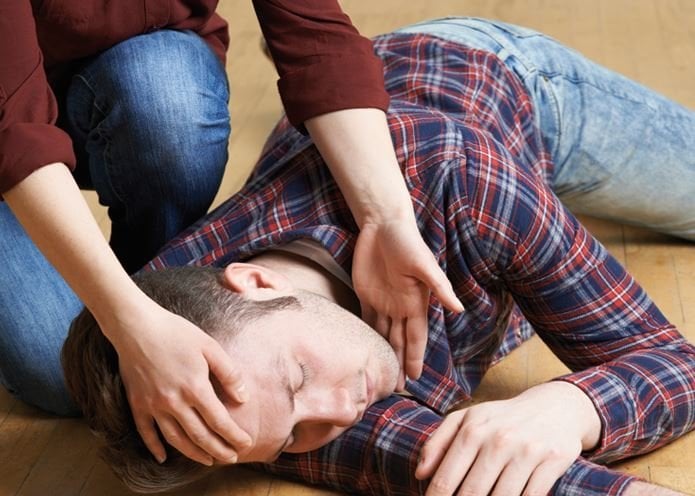Everything about seizures and proper handling

Many people think that a seizure is a condition when a person’s body shakes, shakes, or jerks rapidly and rhythmically out of control. In fact, not all of these conditions show these signs. There are times when a person does not realize that a person nearby is having a seizure that lasts for a few seconds. So, what exactly are seizures, and what are the causes of this condition? Here’s the review for you.
What are seizures?
Seizures are sudden, uncontrollable electrical disturbances in the brain. This disturbance can cause changes in behavior, movement or feelings, up to your level of consciousness. This condition can be a sign of an abnormality in the central nervous system (brain) or other problems that interfere with brain function.
The seizure severity can vary depending on the type and symptoms it causes. In mild conditions, you may just experience confusion or blankness with a blank stare. But in certain, more severe conditions, you can experience involuntary jerking movements in your arms and legs, shaking your whole body, and lose consciousness.
As for gThis usually takes about 30 seconds to two minutes. If the seizure lasts for five minutes or more, you will need emergency medical attention. Meanwhile, jIf you have had two or more of these conditions, you may have epilepsy.
Various causes of seizures

Basically, the cause of seizures, in both adults and children, is abnormal electrical activity in the brain. For information, sThe nerve el-cells (neurons) in the brain create, send, and receive electrical impulses, which allow the brain’s nerve cells to communicate. When these lines of communication are interrupted, electrical disruptions can occur suddenly and uncontrollably in the brain.
The most common cause of this condition is epilepsy. However, not everyone who experiences this disorder has epilepsy. Sometimes, this condition can be caused by other things, such as:
- Abnormal levels of sodium or glucose in the blood.
- Drugs or illegal drugs, such as amphetamines or cocaine.
- Alcohol abuse.
- Electric shock.
- High fever.
- Heart disease.
- Extreme poisoning.
- Buildup of toxins in the body due to liver or kidney failure.
- Very high blood pressure (malignant hypertension).
- A bite or sting from a venomous animal, such as a snake.
- Lack of sleep.
- Taking medications, such as pain relievers and certain antidepressants or therapy to quit smoking.
- Toxemia or preeclampsia of pregnancy.
- Phenylketonuria which can cause seizures in babies.
- Head trauma that causes a bleeding area in the brain.
- Brain infections, such as meningitis and encephalitis.
- Brain injury that occurs in babies during childbirth.
- Brain problems that occur before birth (congenital brain defects).
- Brain tumor.
- Stroke.
In addition, as reported by MedlinePlus Medical Encyclopedia, sometimes the cause of this electrical activity disruption is unknown. This condition, also known as idiopathic seizures, usually occurs in children and young adults. The family history of epilepsy or seizures is suspected to be a contributing factor.
How to treat seizures
Not all seizures sufferers will need treatment. Reporting from the Mayo Clinic, doctors usually decide to start treatment if you have experienced this disorder more than once. The treatment given will depend on the cause that occurred.
If you have a seizure due to a high fever, treatment will focus on reducing the fever. Medications may also be given to avoid further seizures, especially if you are at risk for the condition at some point. As for epilepsy sufferers generally need medication to control seizures because of the risk of experiencing this condition repeatedly.
However, in general, here are some forms of treatment that doctors may give to treat this electrical activity disorder:
Administration of drugs
Anti-seizure medication is the main way to treat this condition. Several choices of anti-seizure drugs that doctors usually give, namely lorazepam, pregabalin, gabapentin, diazepam, and others. Other medicines may also be given according to your condition.
Surgical and therapeutic procedures
If anti-seizure medications don’t work effectively, you may need to undergo other treatments, depending on the cause of your condition. The following are forms of treatment that may be given:
- Operation. In this procedure, the doctor will remove the area of the brain that is causing seizures. This type of treatment is usually performed on sufferers of this condition which is always caused by a brain disorder in the same area.
- Stimulation of the vagus nerve. In this procedure, sA device is implanted under the skin of the chest to stimulate the vagus nerve in the neck, which sends signals to the brain to prevent seizures.
- Responsive neurostimulation. In this procedure, a device is implanted on the surface of the brain or inside brain tissue to detect electrical disturbance activity and provide electrical stimulation to the part of the brain that is detected to stop the disturbance.
- Deep brain stimulation (DBS). In this procedure, electrodes are placed in specific areas of the brain to produce regulating electrical impulses abnormal brain activity.
- Diet therapy. Having a diet high in fat and low in carbohydrates, also known as the keto diet, can reduce the chances of this condition recurring.
Lifestyle changes
In addition to the above remedies, you also need to adopt a healthy lifestyle to help prevent future seizures. A healthy lifestyle that needs to be implemented, such as adequate rest and avoiding stress and consuming alcohol. Also, avoid other possible triggers, such as flashing lights (incl flash from the phone camera when taking selfies or selfie) or stop taking seizure medications.
The first treatment for sufferers of seizures

Most seizures will stop on their own for a few seconds or minutes. However, during this condition, a person could be injured or injured. Therefore, it is important for you to protect someone who has this condition to prevent them from being injured. The following are steps to protect these sufferers:
- Lay the person in a safe place to prevent them from falling.
- Get rid of any furniture or sharp objects around it that could hit the sufferer.
- Give him a pillow or something soft and flat on his head.
- Loosen tight patient clothing, especially around the neck.
- Tilt the person’s body and head to one side. If vomiting occurs, this position can prevent vomit from getting into the lungs.
- Stay with the person until he recovers or until professional medical help arrives.
- When the jerking or shaking stops, place the participant in a recovery position.
Apart from taking the steps above, there are a number of other things that you need to pay attention to when dealing with someone who is experiencing seizures, namely:
- Do not hold back the jerky movements of the sufferer.
- Do not put anything in the victim’s mouth or between the victim’s teeth during the seizure, including your fingers.
- Don’t try to hold the sufferer’s tongue.
- Do not move the person unless they are in an unsafe place or there is something that may be dangerous for them.
- Do not shake the victim to revive him.
- Do not perform CPR or rescue breaths, unless the jolt has stopped and the person is not breathing or has no pulse.
- Do not feed or drink until the jolt has completely stopped.
What are the signs that a seizure needs to be watched out for?
The signs and symptoms of a seizure can vary from person to person. Some of the symptoms that commonly arise from this condition are:
- Temporary confusion.
- Idle or blank stare.
- Cognitive or emotional symptoms, such as fear, anxiety, sudden anger, or deja vu.
- Uncontrolled, jerky movements of the arms and legs.
- The whole body trembled.
- Loss of awareness or alertness.
- Suddenly I fell.
- Saliva or froth from the mouth.
- The movement of the eye or the eyeball is turned upwards.
- Teeth clenched together and clenched into fists.

In addition, a person may experience other symptoms such as fear, anxiety, nausea, vertigo, or visual symptoms (such as spots, wavy lines, or flashes of light in the eye), before the seizure occurs.
However, not all sufferers of seizures will experience all of the signs and symptoms above. In fact, this condition can go unnoticed and difficult to detect if a person experiences only mild symptoms, such as temporary confusion or stunnedness.
However, there are some seizure symptoms and conditions that need to be watched out for and require emergency medical help. The following are the conditions:
- Have seizures for longer than five minutes.
- This is the first time experiencing this condition.
- Not breathing, losing consciousness, or behaving abnormally after the jerking or shaking has stopped.
- The second symptom comes on quickly.
- Have a high fever.
- You hurt yourself because of the condition.
- Is pregnant.
- Have a history of diabetes.
- Experiencing seizures in the water.
- Have other symptoms or conditions that are not common and different from other sufferers.
Based on these symptoms and conditions, the doctor will make a diagnosis to ensure the cause and the right treatment. In making a diagnosis, the doctor will ask your medical history and perform some examination tests, such as pneurological examination, blood test, urine test, lumbar puncture test, electroencephalography (EEG), CT scan, MRI, PET scan, or single-photon emission computerized tomography (SPECT).
Several other tests may be performed depending on the condition of each patient. Consult with your doctor about examination tests that are right for your condition.
Hello Health Group and Hello Sehat do not provide medical advice, diagnosis or treatment. Please check our editorial policy page for more detailed information.